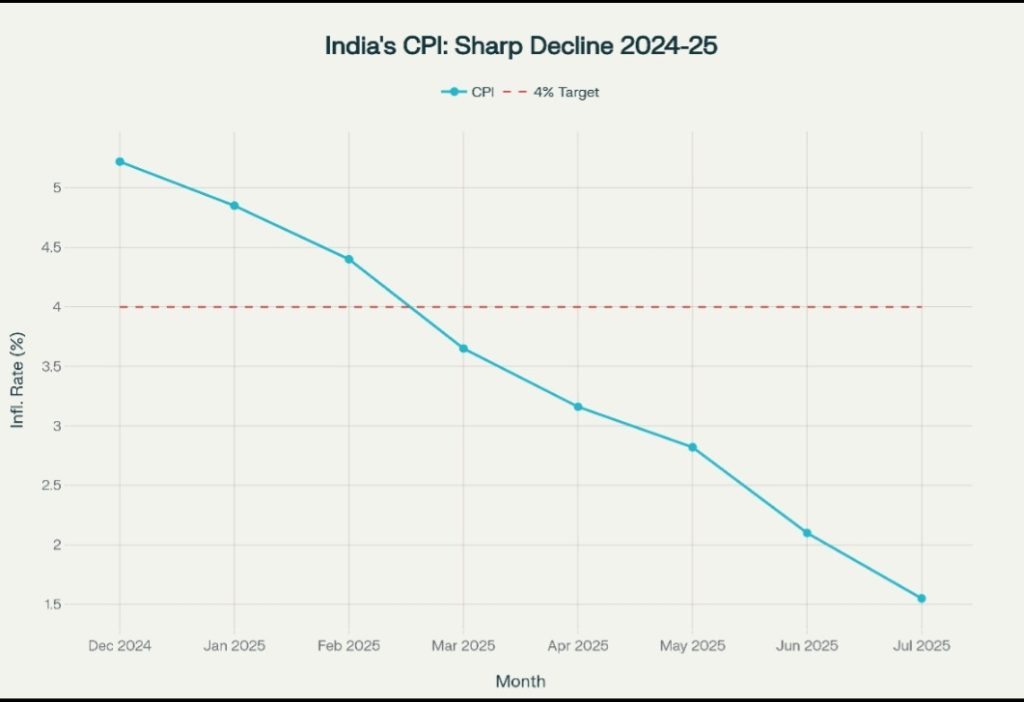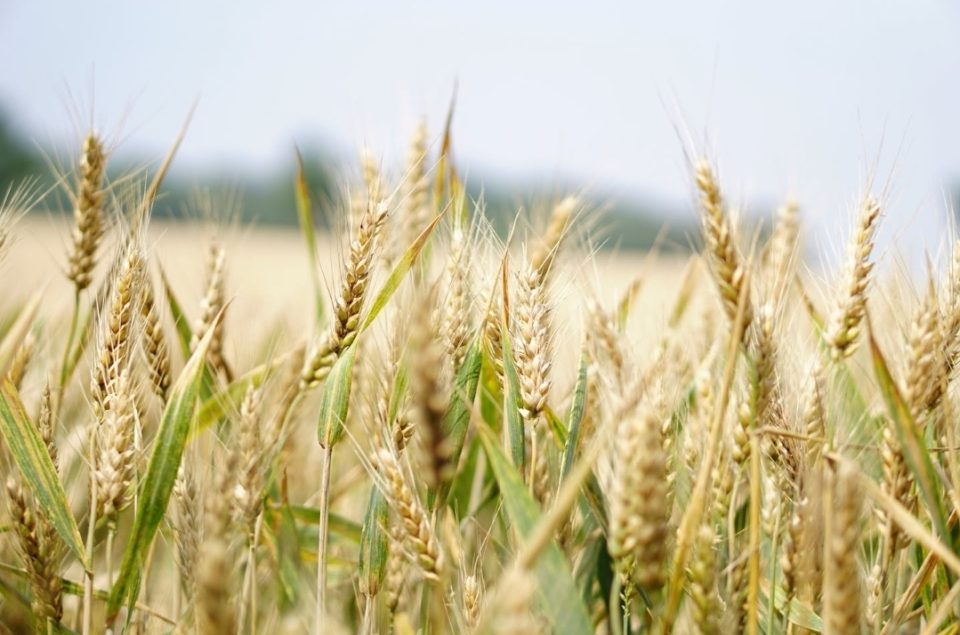India’s Consumer Price Index inflation dropped to a remarkable 1.55% in July 2025—the lowest level since June 2017. This dramatic descent from 2.10% in June represents more than just numbers on a spreadsheet. Moreover, it signals a transformative moment where agricultural abundance, strategic policy interventions, and economic fundamentals aligned to deliver unprecedented relief to Indian consumers.

The Perfect Storm of Positive Forces
The story behind India’s inflation plunge begins with nature’s bounty. Furthermore, the 2025 monsoon season delivered above-normal rainfall for the second consecutive year. Subsequently, this meteorological gift cascaded through India’s agricultural system, creating abundant harvests that directly impacted food prices.
Food prices experienced deflation of -1.76% in July, marking the lowest level since January 2019. Additionally, vegetable prices crashed by 20.69% year-on-year, demonstrating the powerful impact of improved agricultural output. Consequently, this agricultural renaissance directly translated into kitchen-table relief for millions of Indian families.
Meanwhile, the India Meteorological Department’s forecast proved remarkably accurate. Subsequently, rainfall reached 105% of the long-term average, supporting optimal growing conditions for kharif crops. Furthermore, early monsoon onset in May facilitated timely sowing, resulting in significantly higher crop yields across key agricultural states.
Government Intervention: Strategic and Timely
The Finance Ministry deployed targeted fiscal measures to amplify nature’s benefits. Specifically, duty-free imports of essential commodities like pulses and edible oils provided crucial supply-side support. Additionally, import duties on crude edible oils dropped from 27.5% to 16.5%, directly reducing input costs for consumers.
These interventions proved particularly effective because they addressed specific supply constraints. Moreover, extending duty-free imports of yellow peas until March 2026 ensured sustained price stability in the crucial protein segment. Consequently, these measures created a buffer against potential supply shocks while supporting domestic price stability.
Furthermore, government monitoring systems tracked vegetable prices in real-time, enabling swift interventions when needed. Subsequently, organizations like the National Cooperative Consumers’ Federation mobilized to distribute affordable produce during temporary price spikes.
RBI’s Calibrated Monetary Strategy
The Reserve Bank of India’s approach demonstrated sophisticated policy calibration. Initially, the central bank maintained repo rates at 6.5% through early 2025, containing demand-side pressures while inflation remained elevated. Subsequently, as supply-side improvements materialized, the RBI delivered strategic rate cuts totaling 100 basis points.
The RBI’s August 2025 decision to pause rate cuts at 5.5% reflected careful assessment of economic conditions. Moreover, the central bank revised its FY26 inflation forecast downward from 3.7% to 3.1%, acknowledging the sustained disinflationary environment.
Nevertheless, core inflation remained elevated at 4.1% in July, primarily driven by gold price increases. Therefore, the RBI maintained a neutral stance, balancing growth support with inflation vigilance.
The Base Effect Phenomenon
Statistical dynamics significantly amplified the apparent inflation decline. Specifically, the base effect compared current prices against July 2024’s elevated levels. Therefore, when food prices stabilized this year while remaining elevated last year, the mathematical result appeared as dramatic deflation.
However, this statistical effect doesn’t diminish the real benefits consumers experienced. Indeed, month-over-month price increases remained modest even as year-over-year comparisons showed sharp declines. Consequently, households genuinely benefited from improved affordability across essential commodities.
Consumer Experience Transformation
For Indian families, this inflation decline translated into tangible improvements in purchasing power. Subsequently, rural households reported 76.6% experiencing increased consumption, while 39.6% noted higher incomes. Moreover, the cost of a homemade thali dropped 14% year-over-year, directly impacting daily living expenses.
Nevertheless, inflation’s psychological impact extends beyond pure mathematics. Consequently, consumers’ expectations and spending behaviors adapt gradually to price changes. Furthermore, when inflation rises, customer experience expectations typically increase proportionally.
However, India’s current deflationary environment creates opposite dynamics. Therefore, consumers may maintain cautious spending despite improved affordability. Additionally, businesses can focus on service quality rather than constantly justifying price increases.
Regional Variations and Complexities
While national averages show dramatic improvement, regional experiences varied considerably. For instance, Delhi experienced temporary tomato price spikes reaching ₹85 per kg due to localized weather disruptions. However, cities like Chennai and Mumbai maintained more stable pricing at ₹50-58 per kg.
Subsequently, these variations highlight how localized supply chains can create temporary disconnects from national trends. Moreover, monsoon-related transportation disruptions continue affecting specific markets despite overall abundance.
Nevertheless, government intervention mechanisms proved effective in addressing these localized spikes. Furthermore, strategic procurement and distribution through consumer cooperatives provided targeted relief where needed.
Food System Resilience and Structural Changes
India’s agricultural transformation extends beyond seasonal variations. Specifically, farmers increasingly diversify into higher-value crops, reducing dependence on traditional cereals. Subsequently, horticulture output grew 52% over the past decade, compared to 27% for traditional crops.
Moreover, technology adoption accelerated significantly, with precision farming adoption rising from 12% in 2020 to 35% in 2025. Additionally, mobile app usage among farmers increased from 29% to 62% during the same period.
These structural improvements create more resilient supply chains. Furthermore, better storage and processing infrastructure reduces post-harvest losses that historically drove price volatility. Consequently, these developments support sustained price stability beyond immediate seasonal factors.
Wholesale vs. Retail Dynamics
Wholesale price inflation showed even more dramatic deflation at -0.58% in July, indicating producer-level price pressures remained minimal. Moreover, food articles deflation reached -6.29% at wholesale level, demonstrating abundant supply throughout the distribution chain.
However, this wholesale deflation creates mixed implications. Subsequently, while consumers benefit from lower prices, agricultural producers face reduced income potential. Therefore, policymakers must balance consumer affordability with farmer profitability.
Nevertheless, improved productivity and crop diversification help offset price pressures for progressive farmers. Additionally, value-added processing opportunities create alternative revenue streams.
Global Context and External Factors
International commodity price trends supported India’s disinflationary environment. Specifically, global crude oil prices remained relatively stable, reducing fuel and transportation cost pressures. Moreover, favorable global food commodity trends provided additional downward pressure on import-dependent items.
However, external risks remain significant. Subsequently, US trade policies and tariff uncertainties could impact future cost structures. Furthermore, global supply chain disruptions or geopolitical tensions could reverse current favorable trends.
Therefore, maintaining current inflation levels requires continued vigilance regarding external developments. Additionally, domestic policy coordination becomes crucial for sustaining these gains.
Looking Forward: Sustainability and Challenges
The sustainability of current ultra-low inflation presents both opportunities and challenges. First, continued monsoon dependency means future weather variations could quickly reverse current gains. Second, base effects will diminish over time, potentially revealing underlying price pressures.
Moreover, economic growth acceleration could reignite demand-side inflation pressures. Subsequently, the RBI faces delicate balancing between supporting growth and maintaining price stability. Furthermore, global economic developments remain largely beyond domestic control.
Nevertheless, structural improvements in Indian agriculture provide reasons for optimism. Additionally, enhanced policy coordination between fiscal and monetary authorities demonstrates improved economic management capabilities.
The Consumer Experience Revolution
This inflation decline represents more than statistical achievement—it fundamentally transforms the Indian consumer experience. Subsequently, households can allocate resources toward savings, investment, and discretionary spending rather than basic necessities.
Moreover, businesses can focus on service quality and innovation rather than constantly managing price-driven customer relationships. Therefore, this environment enables experience-driven competition rather than purely price-based competition.
Furthermore, reduced inflation volatility creates more predictable planning environments for both consumers and businesses. Consequently, this stability supports longer-term investment and consumption decisions.
The convergence of abundant monsoons, strategic government intervention, and calibrated monetary policy created India’s remarkable inflation decline to 1.55% in July 2025. While challenges remain regarding sustainability and external risks, this achievement demonstrates how coordinated policy responses can deliver tangible benefits to consumers. The transformation from inflationary pressures to deflationary relief has revolutionized the Indian consumer experience, creating space for businesses to compete on value and service rather than constantly justifying price increases. As India continues navigating this new economic landscape, the lessons learned from this inflation success story will prove invaluable for future policy coordination and consumer-focused economic management.

